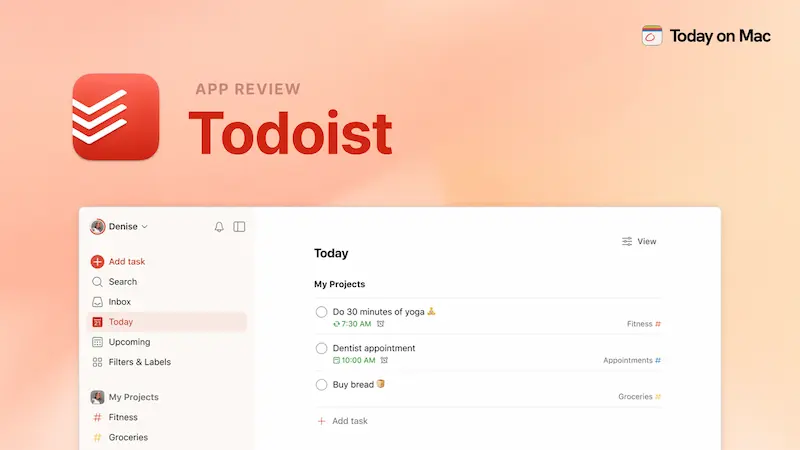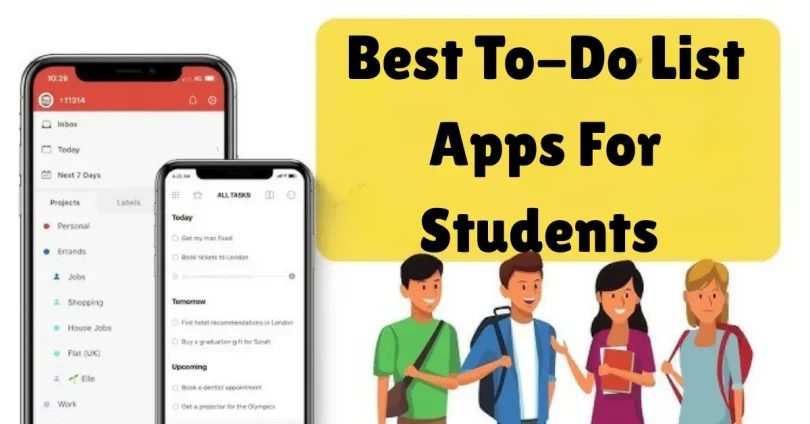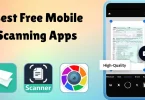Being a student often feels like juggling lectures, assignments, exams, and group projects—all while trying to maintain some kind of social life. With so much going on, it’s easy to miss deadlines or forget important tasks.
That’s exactly why the best to-do list apps for students are total lifesavers. They’re not just digital sticky notes—they help you stay organized, break down big projects into manageable steps, and remind you before it’s too late.
Sure, you can write in a notebook or slap Post-its on your desk, but let’s be honest—they get messy or ignored. A good digital to-do list app keeps everything in one place, syncs across your devices, and actually makes studying and planning easier.
After testing a bunch of options, I’ve narrowed it down to the best to-do list apps for students that are simple, powerful, and practical. Whether you want something minimal, feature-packed, or designed for teamwork, these top picks will help you stay on track.
1. Todoist – Best Overall To-Do List App

If I had to recommend just one app for students, it would be Todoist. It strikes the perfect balance between simplicity and advanced features. The interface is clean and distraction-free, yet powerful enough to manage multiple courses, assignments, and personal tasks.
You can create tasks, sub-tasks, and even recurring reminders (like weekly quizzes or assignment submissions). It also allows you to categorize tasks into projects, which is perfect for organizing by subjects or semesters.
Perfect for: Students who want a smart, reliable, and flexible all-in-one app.
Key features:
- Prioritize tasks with labels, filters, and deadlines
- Set recurring reminders (ideal for repeating classes or study sessions)
- Cross-platform sync on phone, tablet, and laptop
- Integration with apps like Google Calendar and Slack
Pro tip: Use the “Today” view to avoid overwhelm—it shows only what’s due right now.
2. Microsoft To Do – Best Free Option
Not everyone wants to pay for a to-do app, and that’s where Microsoft To Do shines. It’s completely free, has a clean design, and works seamlessly with Outlook and other Microsoft tools.
One of its best features is the “My Day” planner. Every morning, you can pick which tasks you want to focus on, which makes your to-do list feel achievable rather than overwhelming.
Perfect for: Students looking for a free, simple, and straightforward option.
Key features:
- “My Day” view for short-term planning
- Share lists for group projects
- Free cloud sync across devices
- Integrates with Microsoft 365 and Outlook
Pro tip: Use it to separate personal tasks from academic ones—like having one list for “Assignments” and another for “Groceries.”
3. Notion – Best for Customization
If you’re the kind of student who loves building systems and organizing everything in one place, Notion is a game-changer. It’s more than just a to-do list app—you can take notes, build databases, create calendars, and even design a personal dashboard.
For example, you can create a “Semester Planner” page with all your courses, assignments, deadlines, and notes linked together. It feels like a digital binder where everything is in one spot.
Perfect for: Students who want full flexibility and like customizing their study setup.
Key features:
- Drag-and-drop task boards and calendars
- Combine notes, tasks, and schedules in one app
- Free plan available with unlimited pages (students can apply for a free premium upgrade)
- Works well for both solo and group work
Pro tip: Use templates—Notion has tons of free student-friendly ones like “Class Notes,” “Assignment Tracker,” and “Weekly Planner.”
4. Google Keep – Best for Quick Notes & Tasks
Sometimes you don’t need a complex task manager—you just need to jot something down fast. That’s where Google Keep shines. It’s basically digital sticky notes that sync with your Google account.
You can color-code notes, create quick checklists, add voice memos, or even attach images. Plus, if you already use Google Docs, Gmail, or Drive, Keep integrates seamlessly.
Perfect for: Students who want a minimal, fast way to capture tasks and reminders.
Key features:
- Simple checklist and note-taking system
- Voice notes for quick task entry
- Color-coded organization
- Syncs across all Google services
Pro tip: Pin your most urgent notes (like “Assignment due tomorrow”) so they always stay at the top.
You may also like to read this:
Top 15 Latest Green Technology Innovations To Watch Now
Top 8 Blockchain Applications Beyond Cryptocurrency Today
Future Applications of Quantum Computing Explained Guide
How The Impact of 5G on Gadgets Is Changing Technology
AI Ethics Developments And Challenge Explained
5. TickTick – Best for Habit Tracking + To-Do Lists
Studying isn’t just about deadlines—it’s also about building consistent habits. That’s why TickTick is a great option. It combines a powerful task manager with a built-in habit tracker and Pomodoro timer to boost focus.
This means you can track assignments and study habits like “Read 20 minutes daily” or “Practice coding 3x a week” all in one app.
Perfect for: Students who want to manage both academic tasks and personal growth.
Key features:
- Pomodoro timer for focused study sessions
- Habit tracking for routines (exercise, reading, meditation)
- Smart lists that auto-organize tasks
- Calendar integration for long-term planning
Pro tip: Set up recurring habits like “Review notes daily” to build consistency without needing reminders.
6. Trello – Best for Group Projects

Group projects are the ultimate test of patience—and organization. Trello makes them much easier by using Kanban boards. Each project gets its own board, with “To Do,” “Doing,” and “Done” lists that you can move tasks between.
You can assign tasks to specific teammates, add deadlines, attach files, and leave comments. It’s visual, interactive, and way less stressful than endless group chats.
Perfect for: Students working on collaborative assignments or research projects.
Key features:
- Kanban-style boards for task organization
- Assign tasks and deadlines to teammates
- Attach files, links, and notes directly to tasks
- Integrates with Google Drive, Slack, and other tools
Pro tip: Use Trello’s “Butler” automation to automatically move tasks when they’re marked complete.
7. Any.do – Best for Simplicity
If you don’t like clutter, Any.do is a beautifully designed, minimal to-do list app. It focuses on simplicity, so you can quickly add, drag, and reorder tasks without overthinking.
It also has a smart daily planner that prompts you to review your tasks each morning, helping you stay intentional about what’s really important.
Perfect for: Students who prefer a sleek, minimal app without extra features.
Key features:
- Clean and simple drag-and-drop interface
- Daily planner to review priorities
- Voice task creation
- Cross-platform sync (mobile, desktop, web)
Pro tip: Use the Chrome extension to quickly turn emails into tasks.
Tips for Using To-Do Apps Effectively
Downloading the best to-do list app for students is just step one. The real magic happens when you actually use it in a way that boosts productivity and keeps you consistent. Here are some practical tips to get the most out of whichever app you choose:
1. Start with a Daily Review
Every morning (or the night before), open your to-do app and check what’s coming up. Many apps like Microsoft To Do and Any.do even have a “My Day” feature to help you reset and plan for just that day.
Why it works: It keeps your to-do list realistic and prevents overwhelm from looking at every single task in your semester.
2. Use Deadlines, But Don’t Overdo It
Adding deadlines is helpful, but setting a due date for every little thing can lead to alert fatigue. Reserve deadlines for actual non-negotiable tasks (like assignment submissions, exam dates, or project milestones).
Pro tip: For smaller personal tasks like “Read Chapter 3,” just add them to your daily list without a strict due date.
3. Break Big Tasks into Smaller Steps
“Finish research paper” is overwhelming. Instead, break it down into smaller tasks:
- Choose topic
- Gather sources
- Write outline
- Draft introduction
- Edit final version
Apps like Todoist and Notion let you add sub-tasks or checklists that make big projects feel much more manageable.
4. Prioritize with the 1-3-5 Rule
Not all tasks are equal. The 1-3-5 rule is a great way to structure your day:
- 1 big task (like writing an essay draft)
- 3 medium tasks (like revising notes, completing an assignment, or attending class)
- 5 small tasks (emails, quick reminders, daily chores)
Apps like Todoist let you add priority levels so you can easily spot your “big” task of the day.
5. Sync Across All Devices
Make sure your tasks are available on your laptop, phone, and tablet. All the apps on this list support syncing, so you never miss an important deadline just because you left your notebook at home.
6. Leverage Reminders & Notifications
Don’t just rely on memory—use the notification features. Set alerts for at least 30–60 minutes before a class, exam, or assignment deadline. Apps like TickTick and Any.do even allow smart reminders with time and location triggers.
7. Use It for More Than Just School
To-do list apps aren’t just for studies. Add personal tasks, workouts, shopping lists, or even habit tracking. This way, your entire life stays organized in one place. TickTick especially shines here with built-in habit tracking.
8. Review Weekly
At the end of each week, take 10 minutes to look back at what you accomplished and what you didn’t. Apps like Notion make this easy with customizable dashboards where you can track progress.
Why it works: It helps you reset, catch up, and start the new week strong.
Final Thoughts: Best To-Do List Apps For Students
Choosing the right productivity app isn’t about finding the “best” one overall—it’s about finding the one that feels natural to you. Task management is a personal thing. Some students love all-in-one solutions like Notion, while others just want quick notes in Google Keep.
If you’re still unsure, here’s a quick guide:
- Todoist → Best overall balance
- Microsoft To Do → Best free and simple
- Notion → Best for customization
- Google Keep → Best for quick reminders
- TickTick → Best for habit + task tracking
- Trello → Best for group projects
- Any.do → Best for minimalism
At the end of the day, the best to-do list apps for students are the ones you’ll actually use consistently. Try a couple of these, stick with the one that fits your style, and you’ll be amazed at how much more organized (and stress-free) student life feels.
FAQs
1. Which is the best to-do list app for students overall?
Todoist is often considered the best all-rounder because it’s powerful yet simple, works across all devices, and has features like recurring reminders and project organization.
2. Are there any free to-do list apps for students?
Yes! Many great apps are free. Microsoft To Do, Google Keep, and the free versions of Notion and Trello offer excellent features without charging a penny.
3. What is the simplest to-do list app for students?
If you want simplicity, Google Keep and Any.do are great picks. They’re minimal, quick to use, and perfect for students who don’t want to spend time setting up complex features.
4. Which to-do list app is best for group projects?
Trello is the top choice for group projects because it lets you assign tasks, add deadlines, and collaborate visually using boards and cards.|
5. Can I use these apps offline?
Most apps like Todoist, Notion, and Microsoft To Do allow offline access, and they sync automatically when you reconnect to the internet.





